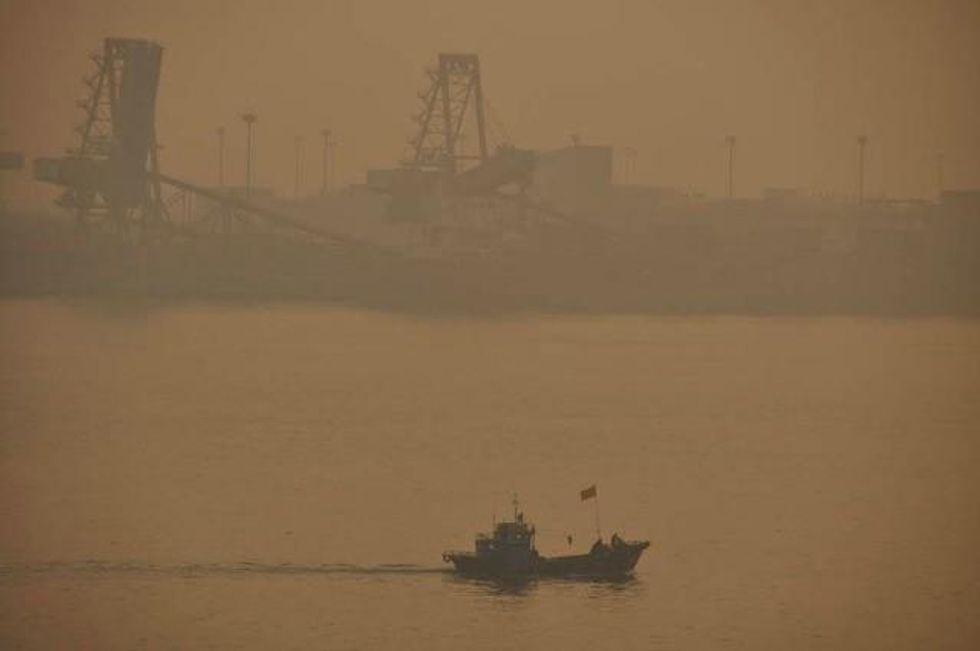In a World Made Toxic, Nearly a Quarter of All Human Deaths Caused by Pollution
Contaminated water, polluted air, chemical waste, climate change, and UV radiation kill 12.6 million people annually, says a new report from the WHO
Nearly a quarter of all deaths around the world are caused by living and working in toxic and polluted environments, and the worst affected are children, the poor, and the elderly, a new report (pdf) released on Tuesday by the World Health Organization (WHO) has found.
"If countries do not take actions to make environments where people live and work healthy, millions will continue to become ill and die too young," said Dr. Margaret Chan, the WHO director-general, according to Business Insider.
The report, which surveyed global causes of deaths in 2012, found that a startling 12.6 million deaths that year could be attributed to toxic environments. The causes ranged from air, water, and soil contamination to climate change.
Children under five accounted for 1.7 million of those deaths--a shocking 26 percent of children's deaths worldwide. The report found that the deaths of 4.9 million adults aged 50 to 75, the other age group most affected, were caused by the environments in which they worked and lived.

Most of these deaths are "attributable to air pollution," the WHO stated. Air pollution alone accounts for 8.2 million annual global deaths, or about two-thirds of the total. The number of deaths from infectious diseases linked to poor water and waste management have declined since the last report a decade ago, the organization noted.
"Stroke was found to be the world's biggest killer in terms of environmental-related deaths," the Independent observed, "claiming the lives of 2.5 million people each year. This was followed by heart disease, which killed 2.3 million people."
The largest number of environmentally-caused deaths were in the Western Pacific and Southeast Asia regions, which alone accounted for 7.3 million annual deaths from environmental causes.
The report suggests several solutions to address the crisis. "Using clean technologies and fuels for domestic cooking, heating and lighting," the WHO stated, "would reduce acute respiratory infections, chronic respiratory diseases, cardiovascular diseases and burns. Increasing access to safe water and adequate sanitation and promoting hand washing would further reduce diarrheal diseases."
But crucially, the organization argues, efforts to combat this public health catastrophe must also tackle large-scale environmental polluters. "Actions by sectors such as energy, transport, agriculture and industry are vital," the report notes, "in cooperation with the health sector, to address the root environmental causes of ill health... actions do not need to come from health alone, but rather from all sectors making decisions which [have an] impact on environmental determinants of health."
An Urgent Message From Our Co-Founder
Dear Common Dreams reader, The U.S. is on a fast track to authoritarianism like nothing I've ever seen. Meanwhile, corporate news outlets are utterly capitulating to Trump, twisting their coverage to avoid drawing his ire while lining up to stuff cash in his pockets. That's why I believe that Common Dreams is doing the best and most consequential reporting that we've ever done. Our small but mighty team is a progressive reporting powerhouse, covering the news every day that the corporate media never will. Our mission has always been simple: To inform. To inspire. And to ignite change for the common good. Now here's the key piece that I want all our readers to understand: None of this would be possible without your financial support. That's not just some fundraising cliche. It's the absolute and literal truth. We don't accept corporate advertising and never will. We don't have a paywall because we don't think people should be blocked from critical news based on their ability to pay. Everything we do is funded by the donations of readers like you. Will you donate now to help power the nonprofit, independent reporting of Common Dreams? Thank you for being a vital member of our community. Together, we can keep independent journalism alive when it’s needed most. - Craig Brown, Co-founder |
Nearly a quarter of all deaths around the world are caused by living and working in toxic and polluted environments, and the worst affected are children, the poor, and the elderly, a new report (pdf) released on Tuesday by the World Health Organization (WHO) has found.
"If countries do not take actions to make environments where people live and work healthy, millions will continue to become ill and die too young," said Dr. Margaret Chan, the WHO director-general, according to Business Insider.
The report, which surveyed global causes of deaths in 2012, found that a startling 12.6 million deaths that year could be attributed to toxic environments. The causes ranged from air, water, and soil contamination to climate change.
Children under five accounted for 1.7 million of those deaths--a shocking 26 percent of children's deaths worldwide. The report found that the deaths of 4.9 million adults aged 50 to 75, the other age group most affected, were caused by the environments in which they worked and lived.

Most of these deaths are "attributable to air pollution," the WHO stated. Air pollution alone accounts for 8.2 million annual global deaths, or about two-thirds of the total. The number of deaths from infectious diseases linked to poor water and waste management have declined since the last report a decade ago, the organization noted.
"Stroke was found to be the world's biggest killer in terms of environmental-related deaths," the Independent observed, "claiming the lives of 2.5 million people each year. This was followed by heart disease, which killed 2.3 million people."
The largest number of environmentally-caused deaths were in the Western Pacific and Southeast Asia regions, which alone accounted for 7.3 million annual deaths from environmental causes.
The report suggests several solutions to address the crisis. "Using clean technologies and fuels for domestic cooking, heating and lighting," the WHO stated, "would reduce acute respiratory infections, chronic respiratory diseases, cardiovascular diseases and burns. Increasing access to safe water and adequate sanitation and promoting hand washing would further reduce diarrheal diseases."
But crucially, the organization argues, efforts to combat this public health catastrophe must also tackle large-scale environmental polluters. "Actions by sectors such as energy, transport, agriculture and industry are vital," the report notes, "in cooperation with the health sector, to address the root environmental causes of ill health... actions do not need to come from health alone, but rather from all sectors making decisions which [have an] impact on environmental determinants of health."
Nearly a quarter of all deaths around the world are caused by living and working in toxic and polluted environments, and the worst affected are children, the poor, and the elderly, a new report (pdf) released on Tuesday by the World Health Organization (WHO) has found.
"If countries do not take actions to make environments where people live and work healthy, millions will continue to become ill and die too young," said Dr. Margaret Chan, the WHO director-general, according to Business Insider.
The report, which surveyed global causes of deaths in 2012, found that a startling 12.6 million deaths that year could be attributed to toxic environments. The causes ranged from air, water, and soil contamination to climate change.
Children under five accounted for 1.7 million of those deaths--a shocking 26 percent of children's deaths worldwide. The report found that the deaths of 4.9 million adults aged 50 to 75, the other age group most affected, were caused by the environments in which they worked and lived.

Most of these deaths are "attributable to air pollution," the WHO stated. Air pollution alone accounts for 8.2 million annual global deaths, or about two-thirds of the total. The number of deaths from infectious diseases linked to poor water and waste management have declined since the last report a decade ago, the organization noted.
"Stroke was found to be the world's biggest killer in terms of environmental-related deaths," the Independent observed, "claiming the lives of 2.5 million people each year. This was followed by heart disease, which killed 2.3 million people."
The largest number of environmentally-caused deaths were in the Western Pacific and Southeast Asia regions, which alone accounted for 7.3 million annual deaths from environmental causes.
The report suggests several solutions to address the crisis. "Using clean technologies and fuels for domestic cooking, heating and lighting," the WHO stated, "would reduce acute respiratory infections, chronic respiratory diseases, cardiovascular diseases and burns. Increasing access to safe water and adequate sanitation and promoting hand washing would further reduce diarrheal diseases."
But crucially, the organization argues, efforts to combat this public health catastrophe must also tackle large-scale environmental polluters. "Actions by sectors such as energy, transport, agriculture and industry are vital," the report notes, "in cooperation with the health sector, to address the root environmental causes of ill health... actions do not need to come from health alone, but rather from all sectors making decisions which [have an] impact on environmental determinants of health."

